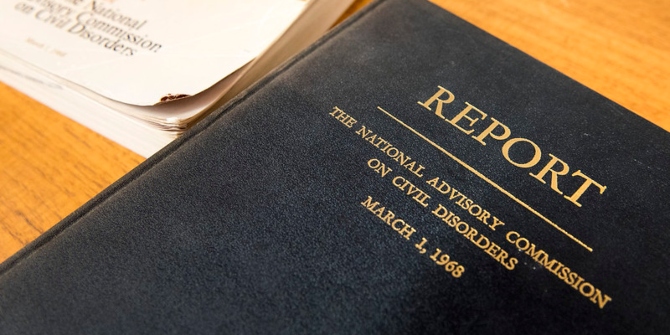 Last month, Colorado became the latest US state to abolish the death penalty. Hollis A. Whitson writes on how the move has been the culmination of years of work from abolitionists and social scientists who built a convincing base of evidence on the racial and geographic disparities of the death penalty in Colorado.
Last month, Colorado became the latest US state to abolish the death penalty. Hollis A. Whitson writes on how the move has been the culmination of years of work from abolitionists and social scientists who built a convincing base of evidence on the racial and geographic disparities of the death penalty in Colorado.
On March 23, 2020, Colorado became the 22nd state to abolish the death penalty. At the same time that Democratic Governor Jared Polis signed the repeal bill into law, he commuted the sentences of all three men on Colorado’s death row to life imprisonment. Within weeks, prosecutors in the last two pending death penalty cases withdrew their requests for the death penalty. In the space of a month, the death penalty simply disappeared from the state.
But the events of 2020 were the culmination of years of work. Since at least 2007, abolitionists had introduced a series of repeal bills and worked to convince courts to rule the penalty unconstitutional, all to no avail. This time, however, conditions were ripe. The death penalty is in a steep decline throughout the United States and the around the world:
- Fewer than 30 people were executed and fewer than 50 sentenced to death in the US in each of the previous five years.
- 60 percent of 2019 Gallup poll respondents preferred a sentence of life without parole over the death penalty, while only 36 percent favored the death penalty.
- In 2018, the Vatican formally changed the Catechism of the Catholic Church, calling capital punishment “an attack on the inviolability and dignity of the person” and deeming it “inadmissible” in all cases.
- By 2016, 102 countries around the globe had abolished the penalty for all crimes while eight had abolished it for ordinary crimes. Six times in recent memory, the United Nations General Assembly adopted a resolution calling for a moratorium on the use of the death penalty.
- 2019 saw the 167th US death row prisoner exonerated, proving that conviction of the innocent was possible.
Colorado’s practice reflected this national and international move away from capital punishment. Prior to repeal, Colorado’s death row housed only three men: all African-American, all from the same jurisdiction, all of whom had even attended the same high school. Colorado had executed only one person in more than fifty years.
To be sure, all of these facts made Colorado ripe for repeal. But what pushed the state over the line this time? Perhaps it was the quiet, persistent work of social scientists, who for two decades had been investigating the facts in hundreds of actual Colorado murder cases, conducting empirical research, and bringing into the public discourse the hard truths that Colorado’s death penalty was being administered in an arbitrary, racially disparate manner.

“Execution Bed” by Josh Rushing is licensed under CC BY NC SA 2.0.
Although in 1984 the United States Supreme Court rejected an empirical study into the racially disparate impact on the death penalty, social scientists in Colorado and elsewhere continued to document the death penalty’s flawed operation. The first such study, conducted by Michael Radelet, Stephanie Hindson, and Hillary Potter at the University of Colorado, examined Colorado homicides and death penalty cases from 1980 to 1999 and identified the race of defendants and victims. While non-Hispanic white victims accounted for 54 percent of all homicide victims, they were almost 82 percent of the victims in cases where the death penalty was sought.
Building on this work, professors at the Sturm College of Law at the University of Denver spearheaded the next generation of empirical research. Sam Kamin, Justin Marceau, Scott Phillips, Wanda Foglia and Meg Beardsley reviewed the circumstances in hundreds of actual Colorado murder cases. They discovered, while the death penalty was an option in over 90 percent of all first-degree murders, it was sought by the prosecution initially in only 3 percent of those killings, pursued all the way through sentencing in only 1 percent of those killings, and obtained in only 0.6 percent of all cases. In other words, almost every murder case could have been prosecuted as a death penalty case, but almost none were. Disturbing racial and geographic disparities were revealed: prosecutors were about five times more likely to seek death against minority defendants than against white defendants. These empirical studies were introduced in various trial courts around the state, raising constitutional challenges to Colorado’s capital statute. Although these challenges were not successful in court, they eventually made their way into the public consciousness.
On May 22, 2013, then-Governor John Hickenlooper issued an order indefinitely putting on hold an execution for one of the three men on Colorado’s death row. In that order, he cited the empirical research as support for his moratorium, saying, “under Colorado’s capital sentencing system, death is not handed down fairly.” In 2015, Colorado jurors rejected the death penalty for a white man who had walked into a packed movie theater with an assault rifle, killed 12 people, and injured 70 more. A different Colorado jury chose the penalty of life imprisonment without parole for a black man who was convicted of stabbing five people to death during a bar robbery. It was becoming harder and harder for death penalty retentionists to argue that in Colorado, only the worst of the worst were receiving the death penalty.
In the 2020 legislative battle, social science arguments were front-and-center. Democratic Rep. Adrienne Benavidez of Adams County, one of the law’s main sponsors, stated, “It’s important that we end that I think it has been a very discriminatory practice, not just towards people of color, but people within geographic areas within the state.” The chair of the Senate Judiciary Committee quoted passages from Professor Radelet’s 2017 Book, The History of the Death Penalty in Colorado. Professors Kamin and Phillips reported their most recent findings of the University of Denver study, which by this point included over 15 years of data from actual Colorado murder cases.
In his statement on March 23, abolishing the death penalty and emptying the state’s death row, Governor Polis recognized “that the death penalty cannot be, and never has been, administered equitably in the State of Colorado.” Social science had won the day.
Please read our comments policy before commenting.
Note: This article gives the views of the author, and not the position of USAPP – American Politics and Policy, nor the London School of Economics.
Shortened URL for this post: https://bit.ly/2A7ozXC
About the author
 Hollis A. Whitson
Hollis A. Whitson
Hollis A. Whitson is a founding partner of the Denver law firm of Samler & Whitson, P.C., where her practice is limited to federal and state appeals and the defense in death penalty prosecutions.






